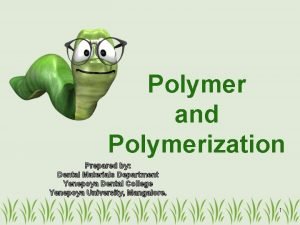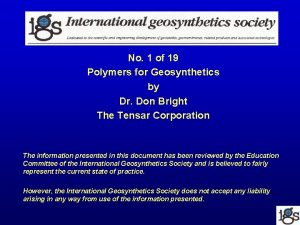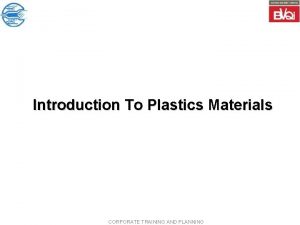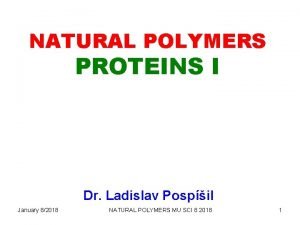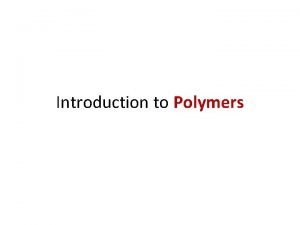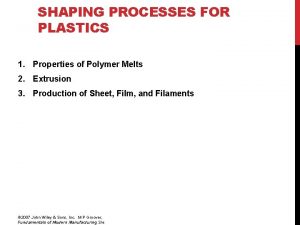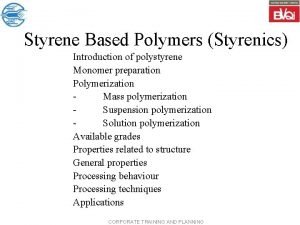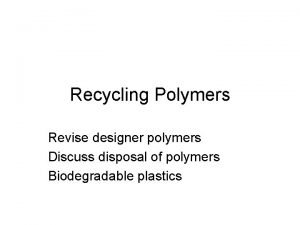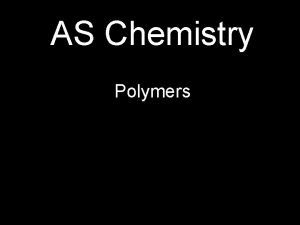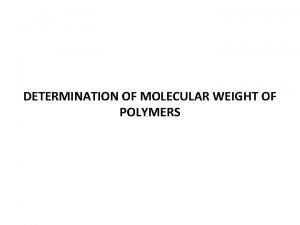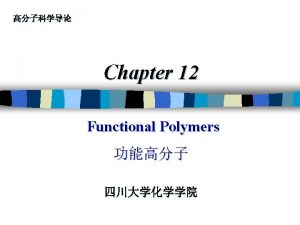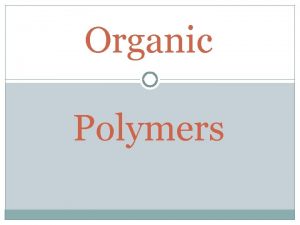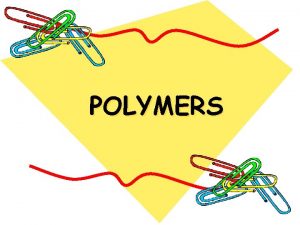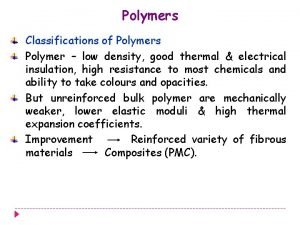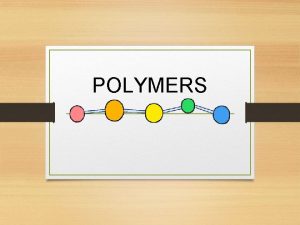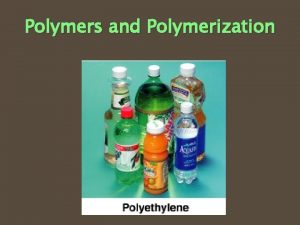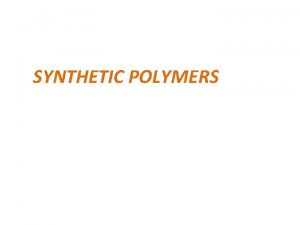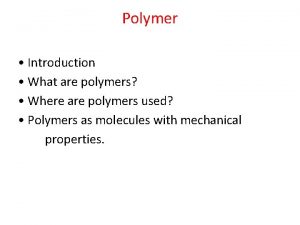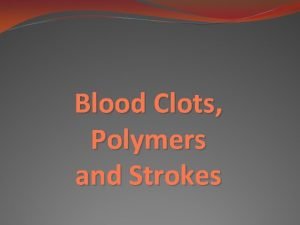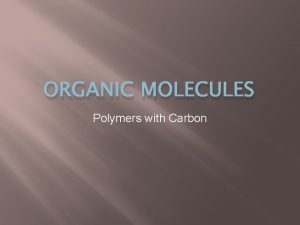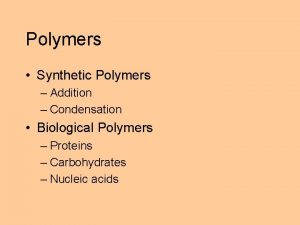Option 2 A Materials polymers Polymers A polymer



















- Slides: 19

Option 2 A Materials (polymers)

Polymers • A polymer is a large molecule made up of many identical repeating units called monomers. • Alkenes are the raw materials in the industrial manufacture of polymers. • In the formation of poly(ethene), the ethene molecule adds to itself to form a long chain consisting of repeating –CH 2 - units. • Poly(ethene), or polythene, is an example of an addition polymer.

Polymerisation of Ethene H H | | 2 n C = C | | H H H | | → [― C ― C ―]n | | H H

Low-density Polythene • Significant degree of branching prevents molecules from packing closely together. • Density of the polymer is reduced. • Very flexible polymer, melting at 360 K. • Used to make plastic bags and squeezy bottles.

Discovery of Polythene • Discovered by accident by Fawcett and Gibson in 1933. • After an experiment at high pressure and temperature involving ethene, a white waxy solid was formed. • This was recognized to be polythene. • Later it was found that if a little oxygen was present with ethene, low-density polythene was formed.

High-density Polythene • Very little branching allows molecules to pack closely together. • Density of the polymer is increased. • More rigid polymer, melting at 400 K. • Used to make buckets and lunch boxes.

Discovery of High-density Polythene • Ziegler made polythene using organic catalysts that contains metal atoms in their molecules. • These catalysts allowed polythene to be made at lower pressure, thus more cheaply. • The polythene produced was relatively rigid with a higher MP, ie high-density polythene.

Polymers of Substituted Alkenes • If a substituted alkene is used, the addition polymer forms in the same way. • The polymer will have different atoms or groups attached to the chain instead of hydrogen atoms. • The polymers will have different physical properties depending on the atoms or groups attached.

Poly(chloroethene) • Chloroethene has a chlorine atom replacing one hydrogen in the ethene molecule. • Chloroethene, CH 2=CHCl, polymerises to form poly(chloroethene). • Compared to poly(ethene), every second carbon in the chain has a chlorine atom attached. • The polymer is commonly known as PVC, and is used to make windows and gutters.

Poly(chloroethene) H H | | 2 n C = C | | H Cl H H | | → [― C ― C ―]n | | H Cl

Poly(phenylethene) • Phenylethene has a phenyl group, C 6 H 5 (a benzene ring with one H removed), replacing one hydrogen in the ethene molecule. • CH 2=CHC 6 H 5 polymerises to form poly(phenylethene). • Compared to poly(ethene), every second carbon in the chain has a phenyl group attached. • The polymer is commonly known as polystyrene, and is used for insulation and packaging.

Poly(phenylethene) H H H | | | 2 n C = C → [― C ― C ―]n | | | H C 6 H 5

Poly(tetrafluoroethene) • Tetrafluoroethene, CF 2=CF 2, has fluorine atoms replacing each hydrogen atom in the ethene molecule. • Tetrafluoroethene, CF 2=CF 2, polymerises to form poly(tetrafluoroethene). • Compared to poly(ethene), every carbon in the chain has 2 fluorine atoms attached. • The polymer is commonly known as Teflon or PTFE, and is used for non-stick coatings.

Poly(tetrafluoroethene) F F | | 2 n C = C | | F F F | | → [― C ― C ―]n | | F F

Discovery of Poly(tetrafluoroethene) • US chemist Roy Plunkett opened a cylinder of C 2 F 4 but no gas came out. • Weight indicated a full cylinder. • Plunkett sawed open cylinder and found a waxy white powder inside. • He realised that a polymerisation reaction had occurred. • Poly(tetrafluoroethene), later called Teflon, was found to have remarkable properties.

Recycling of Plastics • Plastic products are labelled with numbers 1 to 6 to aid sorting. • The plastics are recycled after sorting. • Polystyrene is completely recyclable. • After sorting it is shredded, washed, dried, and then re-extruded.

Poly(propene) • Propene, CH 2=CHCH 3, polymerises to form poly(propene). • Compared to poly(ethene), every second carbon in the chain has a methyl group attached. • The polymer is commonly known as polypropylene. • It is used to make ropes and stacking chairs.

Poly(propene) H H H | | | 2 n C = C → [― C ― C ―]n | | | H CH 3

Uses of Polymers Monomer Polymer Common Name Uses Ethene Poly(ethene) Polythene Low-density: plastic bags, squeezy bottles. Highdensity: buckets, lunch boxes. Chloroethe ne Poly(chloroethene ) Polyvinylchloride (PVC) Garden hoses, window frames, gutters. Phenylethe ne Poly(phenylethene ) Polystyrene Insulation, packaging Tetrafluor oethene Poly(tetrafluoroe thene) Teflon (PTFE) Non-stick coatings, artificial arteries
 Konvergensi option adalah
Konvergensi option adalah Option terminology
Option terminology Polymer in dentistry
Polymer in dentistry Adopting materials
Adopting materials Favourite cars
Favourite cars Direct materials budget with multiple materials
Direct materials budget with multiple materials Harmful and useful material
Harmful and useful material Natural materials and man made materials
Natural materials and man made materials Geosynthetics polymers
Geosynthetics polymers Molecular weight distribution of polymers
Molecular weight distribution of polymers Polymers product design
Polymers product design Pospil
Pospil Vahe gabuchian
Vahe gabuchian Chemsheets as 1098 answers
Chemsheets as 1098 answers Characteristics of polymers
Characteristics of polymers Polystyrene properties
Polystyrene properties Designer polymers
Designer polymers Repeating unit
Repeating unit Polymers advantages
Polymers advantages Molecular weight determination methods
Molecular weight determination methods


